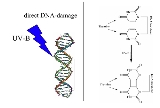
Sunburn
Encyclopedia
A sunburn is a burn
to living tissue, such as skin
, which is produced by overexposure to ultraviolet
(UV) radiation, commonly from the sun
's rays. Usual mild symptoms in humans and other animals include red or reddish skin that is hot to the touch, general fatigue, and mild dizziness. An excess of UV radiation can be life-threatening in extreme cases. Exposure of the skin to lesser amounts of UV radiation will often produce a suntan
.
Excessive UV radiation is the leading cause of primarily non-malignant skin tumor
s. Sunscreen
is widely agreed to prevent sunburn, although some scientists argue that it may not effectively protect against malignant melanoma, which either is caused by a different part of the ultraviolet spectrum or is not caused by sun exposure at all. Clothing, including hats, is considered the preferred skin protection method. Moderate sun tanning
without burning can also prevent subsequent sunburn, as it increases the amount of melanin
, a skin photoprotectant
pigment
that is the skin's natural defense against overexposure. Importantly, both sunburn and the increase in melanin production are triggered by direct DNA damage
. When the skin cells' DNA is damaged by UV radiation, type I cell-death
is triggered and the skin is replaced. Malignant melanoma may occur as a result of indirect DNA damage
if the damage is not properly repaired. Proper repair occurs in the majority of DNA damage. The only cure for sunburn is slow healing, although some skin creams can help with the symptoms.
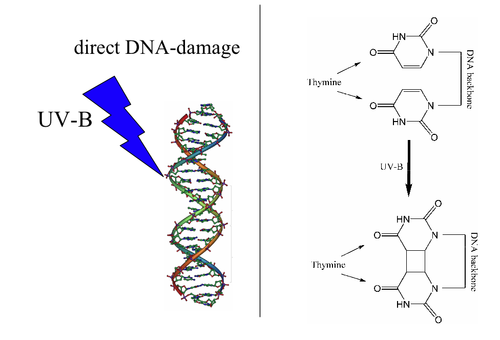 Sunburn is caused by UV radiation, either from the sun or from artificial sources, such as welding
Sunburn is caused by UV radiation, either from the sun or from artificial sources, such as welding
arcs, the lamps used in sunbeds, and ultraviolet germicidal irradiation
. It is a reaction of the body to the direct DNA damage, which can result from the excitation of DNA by UV-B light. This damage is mainly the formation of a thymine dimer. The damage is recognized by the body, which then triggers several defense mechanisms, including DNA repair to revert the damage and increased melanin production to prevent future damage. Melanin transforms UV-photons quickly into harmless amounts of heat without generating free radicals, and is therefore an excellent photoprotectant
against direct and indirect DNA damage.
The pain may be caused by overproduction of a protein called CXCL5, which activates nerve fibres.
It has been shown that protection against sunburn with chemical sunscreens does not imply protection against other damaging effects of UV radiation.
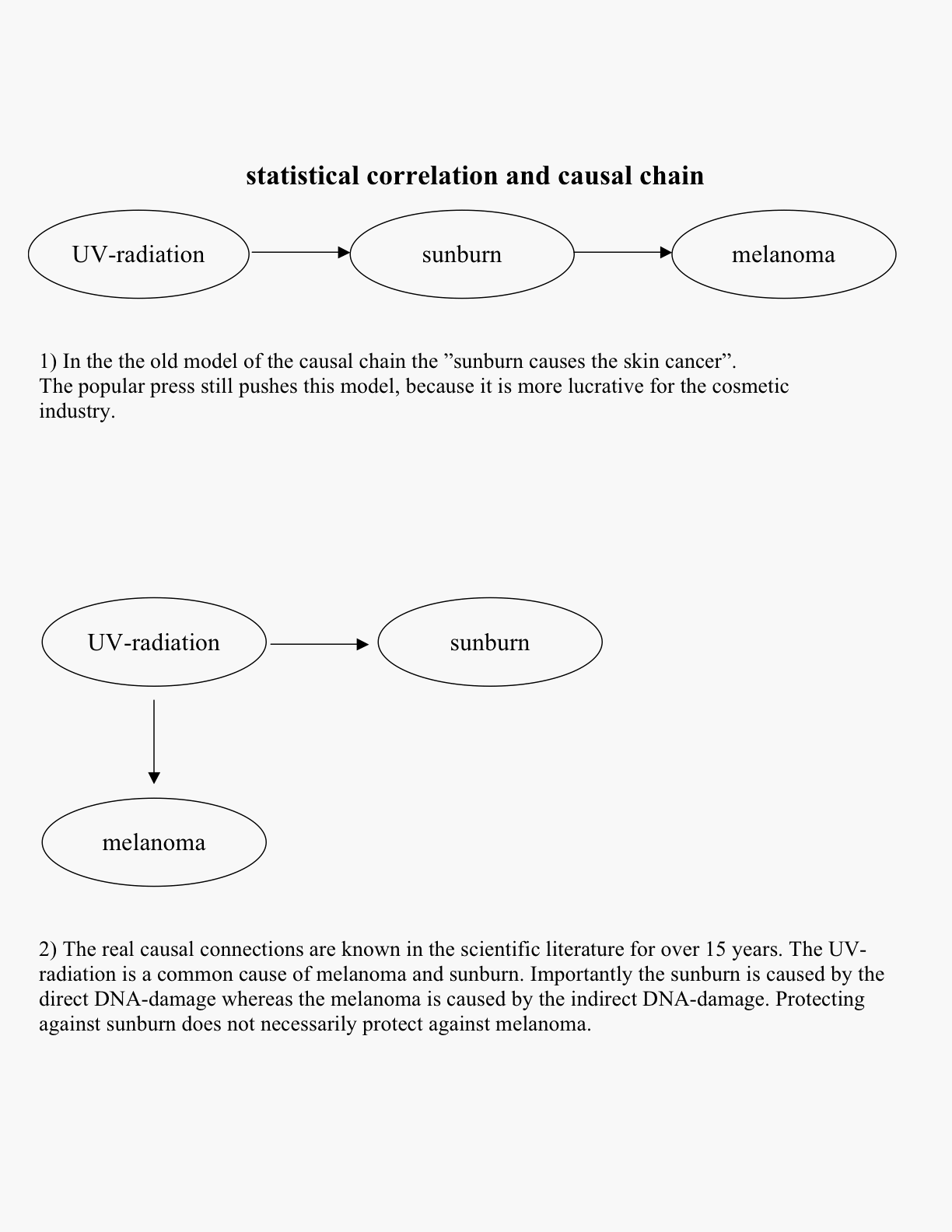
.
Topically applied sunscreen blocks UV rays as long as it does not penetrate into the skin. This prevents sunburn, suntanning, and skin cancer. If the sunscreen filter is absorbed into the skin, it prevents sunburn, but increases the amount of free radicals, which in turn increases the risk for malignant melanoma. The harmful effect of photo-excited sunscreen filters on living tissue has been shown in many photo-biological studies. Whether sunscreen prevents or promotes the development of melanoma depends on the relative importance of the protective effect from the topical sunscreen versus the harmful effects of the absorbed sunscreen.
The use of sunscreen is known to prevent the direct DNA damage that causes sunburn and the two most common forms of skin cancer, basal-cell carcinoma and squamous cell carcinoma. However, if sunscreen penetrates into the skin, it promotes indirect DNA damage, which causes the most lethal form of skin cancer, malignant melanoma. This form of skin cancer is rare, but it causes 75% of all skin cancer-related deaths. Increased risk of malignant melanoma in sunscreen users has been the subject of many epidemiological studies.
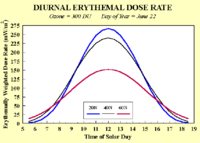 Because of variations in the intensity of UV radiation passing through the atmosphere, the risk of sunburn increases with proximity to the tropic latitudes
Because of variations in the intensity of UV radiation passing through the atmosphere, the risk of sunburn increases with proximity to the tropic latitudes
, located between 23.5° north and south latitude. All else being equal (e.g., cloud
cover, ozone layer
, terrain
, etc.), over the course of a full year, each location within the tropic or polar region
s receives approximately the same amount of UV radiation. In the temperate zones
between 23.5° and 66.5°, UV radiation varies by latitude. The higher the latitude, the lower the intensity of the UV rays.
On a minute
-by-minute basis, the amount of UV radiation is dependent on the angle of the sun. This is easily determined by the height ratio
of any object to the size of its shadow
. The greatest risk is at solar
noon
, when shadows are at their minimum and the sun's radiation passes more directly through the atmosphere. Regardless of one's latitude (assuming no other variables), equal shadow lengths mean equal amounts of UV radiation.
s, oral contraceptives, and tranquillizers have this effect. In general, people with fair hair and/or freckle
s have a greater risk of sunburn than others because of their lighter skin tone.
. Ozone depletion
and the seasonal ozone hole have led to dangerously high levels of UV radiation. Incidence of skin cancer in Queensland
, Australia
had risen to 75 percent among those over 64 years of age by about 1990, due, it is presumed, to thinning of the ozone layer. It was pointed out by Garland et al. that the melanoma rate in Queensland had taken a steep rise before the rest of Australia experienced the same increase of melanoma numbers. They blamed the vigorous promotion of sunscreen, which was first done in Queensland, while sunscreen use was encouraged in the rest of Australia some time later. An effect that would stem from the ozone depletion could not differ from territory to territory within Australia, but sunscreen endorsement programs could. Another study from Norway points out that there had been no change in the ozone layer during the period 1957 to 1984, yet the yearly incidence of melanoma in Norway had increased by 350% for men and by 440% for women. They concluded that in Norway "ozone depletion is not the cause of the increase in skin cancers".
, which naturally develop in some individuals as a protective mechanism against the sun, are viewed by many in the Western world as desirable. This has led to increased exposure to UV radiation from both the natural sun and solaria
.
), followed by varying degrees of pain
, proportional in severity to both the duration and intensity of exposure.
 Other symptoms are edema
Other symptoms are edema
, itching, peeling skin, rash
, nausea
, fever
, and syncope
. Also, a small amount of heat is given off from the burn, caused by the concentration of blood in the healing process, giving a warm feeling to the affected area. Sunburns may be first- or second-degree burns
.
One should immediately speak to a dermatologist if one develops a skin lesion that has an asymmetrical form, has darker edges than center, changes color, or becomes larger than 1/4 inch (6 mm). (see Melanoma
)
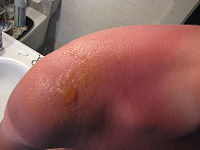 Minor sunburns typically cause nothing more than slight redness and tenderness to the affected areas. In more serious cases, blistering can occur. Extreme sunburns can be painful to the point of debilitation and may require hospital care.
Minor sunburns typically cause nothing more than slight redness and tenderness to the affected areas. In more serious cases, blistering can occur. Extreme sunburns can be painful to the point of debilitation and may require hospital care.
After the exposure, skin may turn red in as little as 30 minutes but most often takes 2 to 6 hours. Pain is usually most extreme 6 to 48 hours after exposure. The burn continues to develop for 24 to 72 hours, occasionally followed by peeling skin in 3 to 8 days. Some peeling and itching may continue for several weeks.
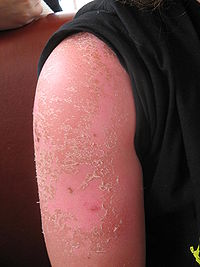 In order to prevent sunburn, the amount of UV radiation reaching the skin must be reduced. The strength of sunlight is published in many locations as a UV index
In order to prevent sunburn, the amount of UV radiation reaching the skin must be reduced. The strength of sunlight is published in many locations as a UV index
. The World Health Organization
recommends to limit time in the midday sun (between 10 a.m. and 4 p.m.), to watch the UV index, to seek shade, to wear protective clothing and a wide-brim hat, and to use sunscreen. Sunlight is generally strongest when the sun is close to the highest point in the sky. Due to time zones and daylight saving time
, this is not necessarily at 12 p.m., but often one to two hours later.
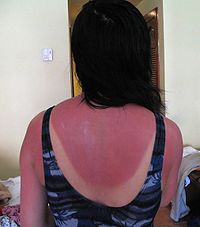 Commercial preparations are available that block UV light, known as sunscreens or sunblocks. They have a sunburn protection factor (SPF) rating, based on the sunblock's ability to suppress sunburn: The higher the SPF rating the lower the amount of direct DNA damage.
Commercial preparations are available that block UV light, known as sunscreens or sunblocks. They have a sunburn protection factor (SPF) rating, based on the sunblock's ability to suppress sunburn: The higher the SPF rating the lower the amount of direct DNA damage.
A sunscreen rated as SPF 10 blocks 90% of the sunburn-causing UVB radiation; an SPF20-rated sunscreen blocks 95%. Modern sunscreens contain filters for UVA radiation as well as UVB. The stated protection factors are correct only if 2 μl of sunscreen is applied per square cm of exposed skin. This translates into about 28 ml (1 oz) to cover the whole body of an adult male, which is much more than many people use in practice. Although UVA radiation does not cause sunburn, it does contribute to skin aging and an increased risk of skin cancer. Many sunscreens provide broad-spectrum protection, meaning that they protect against both UVA and UVB radiation.
Research has shown that the best protection is achieved by application 15 to 30 minutes before exposure, followed by one reapplication 15 to 30 minutes after exposure begins. Further reapplication is necessary only after activities such as swimming, sweating, and rubbing. This varies based on the indications and protection shown on the label — from as little as 80 minutes in water to a few hours, depending on the product selected.
When one is exposed to any artificial source of occupational UV, special protective clothing (for example, welding
helmets/shields) should be worn.
There is also evidence that common foods may have some protective ability against sunburn if taken for a period before the exposure. Beta-carotene and lycopene, chemicals found in tomatoes and other fruit, have been found to increase the skin's ability to resist the effects of UV light. In a 2007 study, after about 10–12 weeks of eating tomato-derived products, a decrease in sensitivity toward UV was observed in volunteers. Ketchup and tomato puree are both high in lycopene. Dark chocolate rich in flavonoids has also been found to have a similar effect if eaten for long periods before exposure.
or glasses
that block UV light should also be worn. UV light has been implicated in the development of age-related macular degeneration, pterygium and cataract
. Concentrated clusters of melanin, commonly known as freckles, are often found within the iris.
) may also help with sunburn pain and swelling. The peeling that comes after some sunburn is unstoppable. However, lotion may relieve the itching. Acetaminophen (such as Tylenol
), Nonsteroidal anti-inflammatory drugs (such as Ibuprofen
or Naproxen
), and Aspirin
have all shown to reduce the pain of sunburns.
Burn
A burn is an injury to flesh caused by heat, electricity, chemicals, light, radiation, or friction.Burn may also refer to:*Combustion*Burn , type of watercourses so named in Scotland and north-eastern England...
to living tissue, such as skin
Skin
-Dermis:The dermis is the layer of skin beneath the epidermis that consists of connective tissue and cushions the body from stress and strain. The dermis is tightly connected to the epidermis by a basement membrane. It also harbors many Mechanoreceptors that provide the sense of touch and heat...
, which is produced by overexposure to ultraviolet
Ultraviolet
Ultraviolet light is electromagnetic radiation with a wavelength shorter than that of visible light, but longer than X-rays, in the range 10 nm to 400 nm, and energies from 3 eV to 124 eV...
(UV) radiation, commonly from the sun
Sun
The Sun is the star at the center of the Solar System. It is almost perfectly spherical and consists of hot plasma interwoven with magnetic fields...
's rays. Usual mild symptoms in humans and other animals include red or reddish skin that is hot to the touch, general fatigue, and mild dizziness. An excess of UV radiation can be life-threatening in extreme cases. Exposure of the skin to lesser amounts of UV radiation will often produce a suntan
Sun tanning
Sun tanning or simply tanning is the process whereby skin color is darkened or tanned. The process is most often a result of exposure to ultraviolet radiation from the sun or from artificial sources, such as a tanning bed, but can also be a result of windburn or reflected light...
.
Excessive UV radiation is the leading cause of primarily non-malignant skin tumor
Tumor
A tumor or tumour is commonly used as a synonym for a neoplasm that appears enlarged in size. Tumor is not synonymous with cancer...
s. Sunscreen
Sunscreen
Sunblock is a lotion, spray, gel or other topical product that absorbs or reflects some of the sun's ultraviolet radiation on the skin exposed to sunlight and thus helps protect against sunburn...
is widely agreed to prevent sunburn, although some scientists argue that it may not effectively protect against malignant melanoma, which either is caused by a different part of the ultraviolet spectrum or is not caused by sun exposure at all. Clothing, including hats, is considered the preferred skin protection method. Moderate sun tanning
Sun tanning
Sun tanning or simply tanning is the process whereby skin color is darkened or tanned. The process is most often a result of exposure to ultraviolet radiation from the sun or from artificial sources, such as a tanning bed, but can also be a result of windburn or reflected light...
without burning can also prevent subsequent sunburn, as it increases the amount of melanin
Melanin
Melanin is a pigment that is ubiquitous in nature, being found in most organisms . In animals melanin pigments are derivatives of the amino acid tyrosine. The most common form of biological melanin is eumelanin, a brown-black polymer of dihydroxyindole carboxylic acids, and their reduced forms...
, a skin photoprotectant
Photoprotection
Photoprotection is a group of mechanisms that nature has developed to minimize the damage that the human body suffers when exposed to UV radiation...
pigment
Pigment
A pigment is a material that changes the color of reflected or transmitted light as the result of wavelength-selective absorption. This physical process differs from fluorescence, phosphorescence, and other forms of luminescence, in which a material emits light.Many materials selectively absorb...
that is the skin's natural defense against overexposure. Importantly, both sunburn and the increase in melanin production are triggered by direct DNA damage
Direct DNA damage
Direct DNA damage can occur when DNA directly absorbs the UV-B-photon. UVB light causes thymine base pairs next to each other in genetic sequences to bond together into thymine dimers, a disruption in the strand, which reproductive enzymes cannot copy...
. When the skin cells' DNA is damaged by UV radiation, type I cell-death
Apoptosis
Apoptosis is the process of programmed cell death that may occur in multicellular organisms. Biochemical events lead to characteristic cell changes and death. These changes include blebbing, cell shrinkage, nuclear fragmentation, chromatin condensation, and chromosomal DNA fragmentation...
is triggered and the skin is replaced. Malignant melanoma may occur as a result of indirect DNA damage
Indirect DNA damage
Indirect DNA damage occurs when a UV-photon is absorbed in the human skin by a chromophore that does not have the ability to convert the energy into harmless heat very quickly. Molecules that do not have this ability have a long lived excited state. This long lifetime leads to a high probability...
if the damage is not properly repaired. Proper repair occurs in the majority of DNA damage. The only cure for sunburn is slow healing, although some skin creams can help with the symptoms.
Cause

Welding
Welding is a fabrication or sculptural process that joins materials, usually metals or thermoplastics, by causing coalescence. This is often done by melting the workpieces and adding a filler material to form a pool of molten material that cools to become a strong joint, with pressure sometimes...
arcs, the lamps used in sunbeds, and ultraviolet germicidal irradiation
Ultraviolet germicidal irradiation
Ultraviolet germicidal irradiation is a sterilization method that uses ultraviolet light at sufficiently short wavelength to kill microorganisms. It is used in a variety of applications, such as food, air and water purification. UV has been a known mutagen at the cellular level for more than...
. It is a reaction of the body to the direct DNA damage, which can result from the excitation of DNA by UV-B light. This damage is mainly the formation of a thymine dimer. The damage is recognized by the body, which then triggers several defense mechanisms, including DNA repair to revert the damage and increased melanin production to prevent future damage. Melanin transforms UV-photons quickly into harmless amounts of heat without generating free radicals, and is therefore an excellent photoprotectant
Photoprotection
Photoprotection is a group of mechanisms that nature has developed to minimize the damage that the human body suffers when exposed to UV radiation...
against direct and indirect DNA damage.
The pain may be caused by overproduction of a protein called CXCL5, which activates nerve fibres.
It has been shown that protection against sunburn with chemical sunscreens does not imply protection against other damaging effects of UV radiation.

Sunburn and skin cancer
Ultraviolet B (UVB) radiation causes dangerous sunburns and increases the risk of two types of skin cancer: basal-cell carcinoma and squamous cell carcinomaSquamous cell carcinoma
Squamous cell carcinoma , occasionally rendered as "squamous-cell carcinoma", is a histologically distinct form of cancer. It arises from the uncontrolled multiplication of malignant cells deriving from epithelium, or showing particular cytological or tissue architectural characteristics of...
.
Controversy over sunscreen
The statement sunburn causes skin cancer is accurate when it refers to either basal-cell carcinoma, the mildest form of cancer, or squamous cell carcinoma. But the statement is false when it comes to malignant melanoma (see picture: UVR sunburn melanoma). The statistical correlation between sunburn and melanoma is due to a common cause — UV radiation. However, they are generated via two different mechanisms: Direct DNA damage is ascribed by many medical doctors to a change in behaviour of the sunscreen user due to a false sense of security afforded by the sunscreen. Other researchers blame insufficient correction for confounding factors; light-skinned individuals versus indirect DNA damage.Topically applied sunscreen blocks UV rays as long as it does not penetrate into the skin. This prevents sunburn, suntanning, and skin cancer. If the sunscreen filter is absorbed into the skin, it prevents sunburn, but increases the amount of free radicals, which in turn increases the risk for malignant melanoma. The harmful effect of photo-excited sunscreen filters on living tissue has been shown in many photo-biological studies. Whether sunscreen prevents or promotes the development of melanoma depends on the relative importance of the protective effect from the topical sunscreen versus the harmful effects of the absorbed sunscreen.
The use of sunscreen is known to prevent the direct DNA damage that causes sunburn and the two most common forms of skin cancer, basal-cell carcinoma and squamous cell carcinoma. However, if sunscreen penetrates into the skin, it promotes indirect DNA damage, which causes the most lethal form of skin cancer, malignant melanoma. This form of skin cancer is rare, but it causes 75% of all skin cancer-related deaths. Increased risk of malignant melanoma in sunscreen users has been the subject of many epidemiological studies.
Location

Tropics
The tropics is a region of the Earth surrounding the Equator. It is limited in latitude by the Tropic of Cancer in the northern hemisphere at approximately N and the Tropic of Capricorn in the southern hemisphere at S; these latitudes correspond to the axial tilt of the Earth...
, located between 23.5° north and south latitude. All else being equal (e.g., cloud
Cloud
A cloud is a visible mass of liquid droplets or frozen crystals made of water and/or various chemicals suspended in the atmosphere above the surface of a planetary body. They are also known as aerosols. Clouds in Earth's atmosphere are studied in the cloud physics branch of meteorology...
cover, ozone layer
Ozone layer
The ozone layer is a layer in Earth's atmosphere which contains relatively high concentrations of ozone . This layer absorbs 97–99% of the Sun's high frequency ultraviolet light, which is potentially damaging to the life forms on Earth...
, terrain
Terrain
Terrain, or land relief, is the vertical and horizontal dimension of land surface. When relief is described underwater, the term bathymetry is used...
, etc.), over the course of a full year, each location within the tropic or polar region
Polar region
Earth's polar regions are the areas of the globe surrounding the poles also known as frigid zones. The North Pole and South Pole being the centers, these regions are dominated by the polar ice caps, resting respectively on the Arctic Ocean and the continent of Antarctica...
s receives approximately the same amount of UV radiation. In the temperate zones
Temperate
In geography, temperate or tepid latitudes of the globe lie between the tropics and the polar circles. The changes in these regions between summer and winter are generally relatively moderate, rather than extreme hot or cold...
between 23.5° and 66.5°, UV radiation varies by latitude. The higher the latitude, the lower the intensity of the UV rays.
On a minute
Minute
A minute is a unit of measurement of time or of angle. The minute is a unit of time equal to 1/60th of an hour or 60 seconds. In the UTC time scale, a minute on rare occasions has 59 or 61 seconds; see leap second. The minute is not an SI unit; however, it is accepted for use with SI units...
-by-minute basis, the amount of UV radiation is dependent on the angle of the sun. This is easily determined by the height ratio
Ratio
In mathematics, a ratio is a relationship between two numbers of the same kind , usually expressed as "a to b" or a:b, sometimes expressed arithmetically as a dimensionless quotient of the two which explicitly indicates how many times the first number contains the second In mathematics, a ratio is...
of any object to the size of its shadow
Shadow
A shadow is an area where direct light from a light source cannot reach due to obstruction by an object. It occupies all of the space behind an opaque object with light in front of it. The cross section of a shadow is a two-dimensional silhouette, or reverse projection of the object blocking the...
. The greatest risk is at solar
Solar time
Solar time is a reckoning of the passage of time based on the Sun's position in the sky. The fundamental unit of solar time is the day. Two types of solar time are apparent solar time and mean solar time .-Introduction:...
noon
Noon
Noon is usually defined as 12 o'clock in the daytime. The word noon is also used informally to mean midday regarding the location of the sun not the middle of a persons day. Although this is a time around the middle of the day when people in many countries take a lunch break...
, when shadows are at their minimum and the sun's radiation passes more directly through the atmosphere. Regardless of one's latitude (assuming no other variables), equal shadow lengths mean equal amounts of UV radiation.
Pharmaceutical products
Sunburn can also be caused by pharmaceutical products that sensitize some users to UV radiation. Certain antibioticAntibiotic
An antibacterial is a compound or substance that kills or slows down the growth of bacteria.The term is often used synonymously with the term antibiotic; today, however, with increased knowledge of the causative agents of various infectious diseases, antibiotic has come to denote a broader range of...
s, oral contraceptives, and tranquillizers have this effect. In general, people with fair hair and/or freckle
Freckle
For other uses of the word, see Freckles .Freckles are clusters of concentrated melanin which are most often visible on people with a fair complexion. A freckle is also called an "ephelis". Freckles do not have an increased number of melanin producing cells...
s have a greater risk of sunburn than others because of their lighter skin tone.
Ozone depletion
In recent years, the incidence and severity of sunburn has increased worldwide, especially in the southern hemisphere, because of damage to the ozone layerOzone layer
The ozone layer is a layer in Earth's atmosphere which contains relatively high concentrations of ozone . This layer absorbs 97–99% of the Sun's high frequency ultraviolet light, which is potentially damaging to the life forms on Earth...
. Ozone depletion
Ozone depletion
Ozone depletion describes two distinct but related phenomena observed since the late 1970s: a steady decline of about 4% per decade in the total volume of ozone in Earth's stratosphere , and a much larger springtime decrease in stratospheric ozone over Earth's polar regions. The latter phenomenon...
and the seasonal ozone hole have led to dangerously high levels of UV radiation. Incidence of skin cancer in Queensland
Queensland
Queensland is a state of Australia, occupying the north-eastern section of the mainland continent. It is bordered by the Northern Territory, South Australia and New South Wales to the west, south-west and south respectively. To the east, Queensland is bordered by the Coral Sea and Pacific Ocean...
, Australia
Australia
Australia , officially the Commonwealth of Australia, is a country in the Southern Hemisphere comprising the mainland of the Australian continent, the island of Tasmania, and numerous smaller islands in the Indian and Pacific Oceans. It is the world's sixth-largest country by total area...
had risen to 75 percent among those over 64 years of age by about 1990, due, it is presumed, to thinning of the ozone layer. It was pointed out by Garland et al. that the melanoma rate in Queensland had taken a steep rise before the rest of Australia experienced the same increase of melanoma numbers. They blamed the vigorous promotion of sunscreen, which was first done in Queensland, while sunscreen use was encouraged in the rest of Australia some time later. An effect that would stem from the ozone depletion could not differ from territory to territory within Australia, but sunscreen endorsement programs could. Another study from Norway points out that there had been no change in the ozone layer during the period 1957 to 1984, yet the yearly incidence of melanoma in Norway had increased by 350% for men and by 440% for women. They concluded that in Norway "ozone depletion is not the cause of the increase in skin cancers".
Popularity of tanning
SuntansSun tanning
Sun tanning or simply tanning is the process whereby skin color is darkened or tanned. The process is most often a result of exposure to ultraviolet radiation from the sun or from artificial sources, such as a tanning bed, but can also be a result of windburn or reflected light...
, which naturally develop in some individuals as a protective mechanism against the sun, are viewed by many in the Western world as desirable. This has led to increased exposure to UV radiation from both the natural sun and solaria
Sunbed
A sunbed , tanning bed or sun tanning bed is a device which emits ultraviolet radiation to produce a cosmetic tan. Regular tanning beds use several fluorescent lamps that have phosphor blends designed to emit UV in a spectrum that is somewhat similar to the sun...
.
Symptoms
Typically there is initial redness (erythemaErythema
Erythema is redness of the skin, caused by hyperemia of the capillaries in the lower layers of the skin. It occurs with any skin injury, infection, or inflammation...
), followed by varying degrees of pain
Pain
Pain is an unpleasant sensation often caused by intense or damaging stimuli such as stubbing a toe, burning a finger, putting iodine on a cut, and bumping the "funny bone."...
, proportional in severity to both the duration and intensity of exposure.

Edema
Edema or oedema ; both words from the Greek , oídēma "swelling"), formerly known as dropsy or hydropsy, is an abnormal accumulation of fluid beneath the skin or in one or more cavities of the body that produces swelling...
, itching, peeling skin, rash
Rash
A rash is a change of the skin which affects its color, appearance or texture. A rash may be localized in one part of the body, or affect all the skin. Rashes may cause the skin to change color, itch, become warm, bumpy, chapped, dry, cracked or blistered, swell and may be painful. The causes, and...
, nausea
Nausea
Nausea , is a sensation of unease and discomfort in the upper stomach with an involuntary urge to vomit. It often, but not always, precedes vomiting...
, fever
Fever
Fever is a common medical sign characterized by an elevation of temperature above the normal range of due to an increase in the body temperature regulatory set-point. This increase in set-point triggers increased muscle tone and shivering.As a person's temperature increases, there is, in...
, and syncope
Syncope (medicine)
Syncope , the medical term for fainting, is precisely defined as a transient loss of consciousness and postural tone characterized by rapid onset, short duration, and spontaneous recovery due to global cerebral hypoperfusion that most often results from hypotension.Many forms of syncope are...
. Also, a small amount of heat is given off from the burn, caused by the concentration of blood in the healing process, giving a warm feeling to the affected area. Sunburns may be first- or second-degree burns
Burn (injury)
A burn is a type of injury to flesh caused by heat, electricity, chemicals, light, radiation or friction. Most burns affect only the skin . Rarely, deeper tissues, such as muscle, bone, and blood vessels can also be injured...
.
One should immediately speak to a dermatologist if one develops a skin lesion that has an asymmetrical form, has darker edges than center, changes color, or becomes larger than 1/4 inch (6 mm). (see Melanoma
Melanoma
Melanoma is a malignant tumor of melanocytes. Melanocytes are cells that produce the dark pigment, melanin, which is responsible for the color of skin. They predominantly occur in skin, but are also found in other parts of the body, including the bowel and the eye...
)
Variations

Duration
Sunburn can occur in less than 15 minutes, and in seconds when exposed to non-shielded welding arcs or other sources of intense ultraviolet light. Nevertheless, the inflicted harm is often not immediately obvious.After the exposure, skin may turn red in as little as 30 minutes but most often takes 2 to 6 hours. Pain is usually most extreme 6 to 48 hours after exposure. The burn continues to develop for 24 to 72 hours, occasionally followed by peeling skin in 3 to 8 days. Some peeling and itching may continue for several weeks.
Skin

UV index
The ultraviolet index or UV Index is an international standard measurement of the strength of the ultraviolet radiation from the sun at a particular place on a particular day...
. The World Health Organization
World Health Organization
The World Health Organization is a specialized agency of the United Nations that acts as a coordinating authority on international public health. Established on 7 April 1948, with headquarters in Geneva, Switzerland, the agency inherited the mandate and resources of its predecessor, the Health...
recommends to limit time in the midday sun (between 10 a.m. and 4 p.m.), to watch the UV index, to seek shade, to wear protective clothing and a wide-brim hat, and to use sunscreen. Sunlight is generally strongest when the sun is close to the highest point in the sky. Due to time zones and daylight saving time
Daylight saving time
Daylight saving time —also summer time in several countries including in British English and European official terminology —is the practice of temporarily advancing clocks during the summertime so that afternoons have more daylight and mornings have less...
, this is not necessarily at 12 p.m., but often one to two hours later.

A sunscreen rated as SPF 10 blocks 90% of the sunburn-causing UVB radiation; an SPF20-rated sunscreen blocks 95%. Modern sunscreens contain filters for UVA radiation as well as UVB. The stated protection factors are correct only if 2 μl of sunscreen is applied per square cm of exposed skin. This translates into about 28 ml (1 oz) to cover the whole body of an adult male, which is much more than many people use in practice. Although UVA radiation does not cause sunburn, it does contribute to skin aging and an increased risk of skin cancer. Many sunscreens provide broad-spectrum protection, meaning that they protect against both UVA and UVB radiation.
Research has shown that the best protection is achieved by application 15 to 30 minutes before exposure, followed by one reapplication 15 to 30 minutes after exposure begins. Further reapplication is necessary only after activities such as swimming, sweating, and rubbing. This varies based on the indications and protection shown on the label — from as little as 80 minutes in water to a few hours, depending on the product selected.
When one is exposed to any artificial source of occupational UV, special protective clothing (for example, welding
Welding
Welding is a fabrication or sculptural process that joins materials, usually metals or thermoplastics, by causing coalescence. This is often done by melting the workpieces and adding a filler material to form a pool of molten material that cools to become a strong joint, with pressure sometimes...
helmets/shields) should be worn.
There is also evidence that common foods may have some protective ability against sunburn if taken for a period before the exposure. Beta-carotene and lycopene, chemicals found in tomatoes and other fruit, have been found to increase the skin's ability to resist the effects of UV light. In a 2007 study, after about 10–12 weeks of eating tomato-derived products, a decrease in sensitivity toward UV was observed in volunteers. Ketchup and tomato puree are both high in lycopene. Dark chocolate rich in flavonoids has also been found to have a similar effect if eaten for long periods before exposure.
Eyes
The eyes are also sensitive to sun exposure, and wrap-around sunglassesSunglasses
Sunglasses or sun glasses are a form of protective eyewear designed primarily to prevent bright sunlight and high-energy visible light from damaging or discomforting the eyes. They can sometimes also function as a visual aid, as variously termed spectacles or glasses exist, featuring lenses that...
or glasses
Glasses
Glasses, also known as eyeglasses , spectacles or simply specs , are frames bearing lenses worn in front of the eyes. They are normally used for vision correction or eye protection. Safety glasses are a kind of eye protection against flying debris or against visible and near visible light or...
that block UV light should also be worn. UV light has been implicated in the development of age-related macular degeneration, pterygium and cataract
Cataract
A cataract is a clouding that develops in the crystalline lens of the eye or in its envelope, varying in degree from slight to complete opacity and obstructing the passage of light...
. Concentrated clusters of melanin, commonly known as freckles, are often found within the iris.
Treatment
The most important aspects of sunburn care are to avoid exposure to the sun while healing and to take precautions to prevent future burns. The best treatment for most sunburns is time. Most sunburns heal completely within a few weeks. Home treatments that help manage the discomfort or facilitate the healing process include using cool and wet cloths on the sunburned areas, taking frequent cold showers or baths, and applying soothing lotions that contain aloe vera to the sunburn areas. Topical steroids (such as 1% hydrocortisone creamCortisol
Cortisol is a steroid hormone, more specifically a glucocorticoid, produced by the adrenal gland. It is released in response to stress and a low level of blood glucocorticoids. Its primary functions are to increase blood sugar through gluconeogenesis; suppress the immune system; and aid in fat,...
) may also help with sunburn pain and swelling. The peeling that comes after some sunburn is unstoppable. However, lotion may relieve the itching. Acetaminophen (such as Tylenol
Tylenol
Tylenol is a North American brand of drugs advertised for reducing pain, reducing fever, and relieving the symptoms of allergies, cold, cough, and flu. The active ingredient of its original, flagship product, paracetamol , is marketed as an analgesic and antipyretic...
), Nonsteroidal anti-inflammatory drugs (such as Ibuprofen
Ibuprofen
Ibuprofen is a nonsteroidal anti-inflammatory drug used for relief of symptoms of arthritis, fever, as an analgesic , especially where there is an inflammatory component, and dysmenorrhea....
or Naproxen
Naproxen
Naproxen sodium is a nonsteroidal anti-inflammatory drug commonly used for the reduction of pain, fever, inflammation and stiffness caused by conditions such as:...
), and Aspirin
Aspirin
Aspirin , also known as acetylsalicylic acid , is a salicylate drug, often used as an analgesic to relieve minor aches and pains, as an antipyretic to reduce fever, and as an anti-inflammatory medication. It was discovered by Arthur Eichengrun, a chemist with the German company Bayer...
have all shown to reduce the pain of sunburns.
See also
- Sun unitSun unitThe sun unit is a measure of sun intensity weighted for skin damage related to the UV index.-Basics of solar radiation:Solar radiation sustains life on earth and determines climate...
- HyperthermiaHyperthermiaHyperthermia is an elevated body temperature due to failed thermoregulation. Hyperthermia occurs when the body produces or absorbs more heat than it can dissipate...
(heat stroke) - WindburnWindburnWindburn is a common term for sunburn accelerated by the effects of wind removing the UV-filtering thin layer of lipids from the skin and irritation caused by the wind. Although colloquially named 'windburn', scientists discovered that the condition is, in fact, the result of sun exposure, and not...
- List of cutaneous conditions
- Potential health risks of sunscreen

